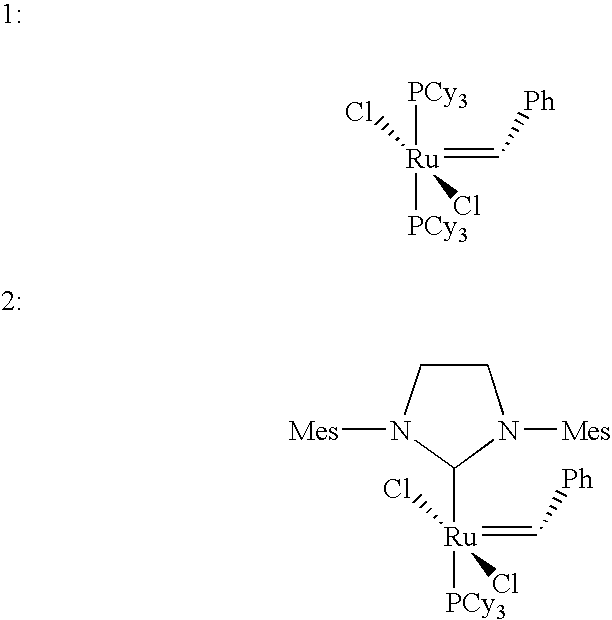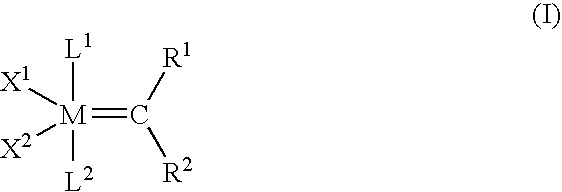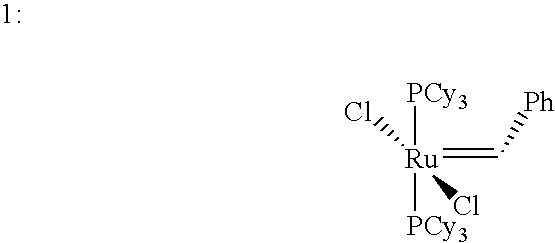Ring-expansion of cyclic olefins metathesis reactions with an acyclic diene
a cyclic olefin and diene technology, applied in the field of cyclic olefin metathesis synthesis, can solve the problems of reducing the activity of catalysts that are more highly stable to polar functional groups, not providing a method for expanding existing cyclic olefins, and presenting several formidable obstacles that must be overcom
- Summary
- Abstract
- Description
- Claims
- Application Information
AI Technical Summary
Benefits of technology
Problems solved by technology
Method used
Image
Examples
example 1
[0223]Using the above general macrocyclization procedures, catalyst 2 (5 mol %) was added to a solution of the acyclic diene having two terminal olefinic groups (e.g., bis-vinyl ketone with octylene linker group) and the cyclic olefin (e.g., cyclopentene) (5 equiv) in an organic solvent (e.g., CH2Cl2) (5 mM of cyclopentene in the acyclic diene solution). After refluxing for 12 h, several products were obtained. The two major products were purified directly on a silica gel column, eluting with 1:4=ethyl acetate:hexane. The major products were the (1+1) fashion (acyclic diene and cycloalkene) ring-expanded product (17 carbon ring atoms macrocycle) 10.0 mg. 43% yield (Rf=0.4 in 1:2=EA:Hx, colorless liquid) and the double ring-expanded product (34 carbon ring atoms macrocycle) 8.0 mg 34% yield (Rf=0.3 in 1:2=EA:Hx, white solid) in a ratio of 1.3 / 1 (Table 2, entry 8, below). Data for the 17 ring atoms macrocycle is: 1H NMR (300 MHz, CDCl3, ppm): δ 6.80(2H, dt, J=6.9, 15.9 Hz), 6.15(2H, d...
example 2
[0224]The procedures in Example 1 was followed while increasing the concentration of the cyclic olefin to 25 mM decreased the product ratio of the 17 atom / 34 atom products to 1 / 2 (Table 2, entry 9).
examples 3 – 5
EXAMPLES 3–5
[0225]Since cyclooctene polymerizes by ring-opening metathesis much faster than cyclopentene due to its higher ring strain, the relationship of concentration of cyclooctene and product distribution was explored (Table 1, entries 3 to 5) using the general procedures of Example 1. The product was purified directly on a silica gel column, eluting with 1:9=ethyl acetate:hexane. With 5 equiv of cyclooctene (5 mM, 5:1 ratio with respect to the acyclic diene), ROMP polymerization of cyclooctene is a significant side reaction and 23% of the undesired double inserted macrocycle (the acyclic diene is expanded with two cyclooctene monomer residues) is obtained (Table 1, entry 3). The singly expanded product that was obtained in 23% yield had a Rf=0.5 in 1:2=EA:Hx, colorless liquid. The data for this structure was: 1H NMR (300 MHz, CDCl3, ppm): δ 6.78(2H, dt, J=7.2, 15.9 Hz), 6.09(2H, dt, J=1.5, 15.9 Hz), 2.49(4H, t, J=6.9 Hz), 2.22(4H, dq, J=1.5, 6.9 Hz), 1.63(4H, m), 1.47(4H, m), ...
PUM
| Property | Measurement | Unit |
|---|---|---|
| Reaction temperatures | aaaaa | aaaaa |
| Reaction temperatures | aaaaa | aaaaa |
| thickness | aaaaa | aaaaa |
Abstract
Description
Claims
Application Information
 Login to View More
Login to View More - R&D
- Intellectual Property
- Life Sciences
- Materials
- Tech Scout
- Unparalleled Data Quality
- Higher Quality Content
- 60% Fewer Hallucinations
Browse by: Latest US Patents, China's latest patents, Technical Efficacy Thesaurus, Application Domain, Technology Topic, Popular Technical Reports.
© 2025 PatSnap. All rights reserved.Legal|Privacy policy|Modern Slavery Act Transparency Statement|Sitemap|About US| Contact US: help@patsnap.com



